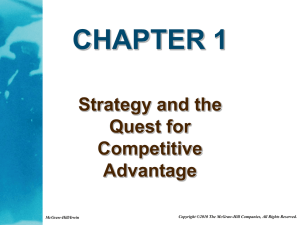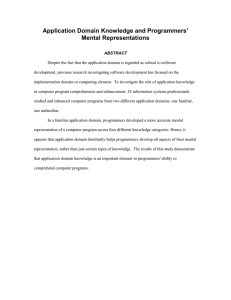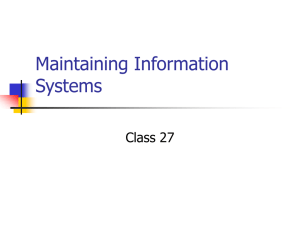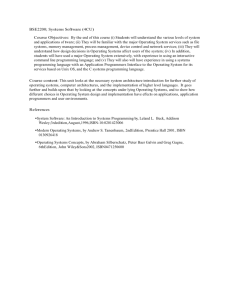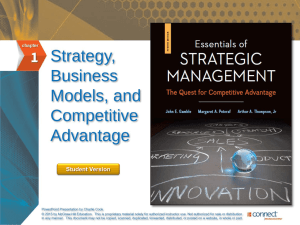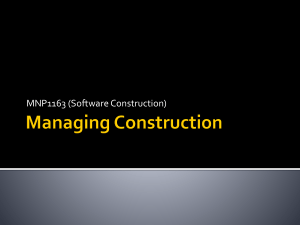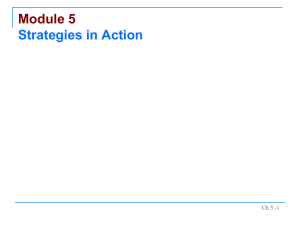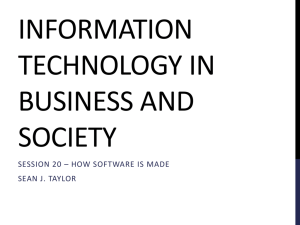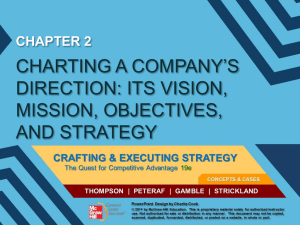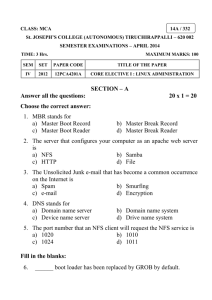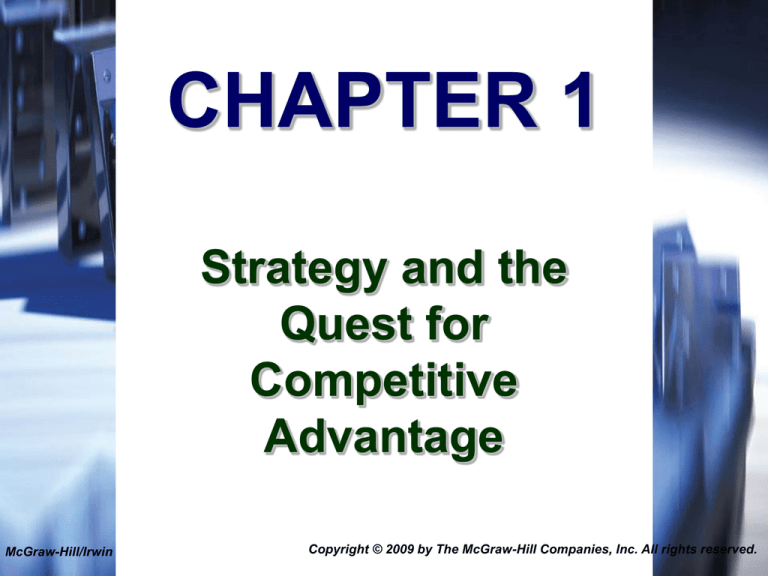
CHAPTER 1
Strategy and the
Quest for
Competitive
Advantage
McGraw-Hill/Irwin
Copyright © 2009 by The McGraw-Hill Companies, Inc. All rights reserved.
1-1
Thinking Strategically:
The Three Big Strategic Questions
1. Where are we now?
External and Internal Analysis
2. Where
do we want to go?
Vision and Objectives
Business(es) to be in and market positions
Buyer needs and groups
3. How
are we going to get there?
This is its strategy
1-2
What Do We Mean By “Strategy”?
Consists of competitive moves and
business approaches used by
managers to run the company
Management’s “action plan” to
Attract and please customers
Compete successfully
Conduct operations
Achieve target levels of
organizational performance
1-3
Strategy and Sustainable
Competitive Advantage
A company achieves sustainable
competitive advantage when a
sufficiently large
number of buyers
develop a lasting
preference for its
products/services over
those offered by rivals
1-4
Four Proven Strategic Approaches to
Winning a Sustainable Competitive
Advantage
Developing a cost-based advantage
Creating a differentiation-based
advantage
Focusing on a narrow market niche
within an industry
Developing
unmatched resource
strengths and
competitive capabilities
1-5
Competitive Strategy Examples
Strive to be the industry’s low-cost provider
Wal-Mart
Southwest Airlines
Out-compete rivals on a key differentiating
feature
Harley-Davidson – Outlaw image and
distinctive engine sound
Rolex – Top-of-the-line prestige
Amazon.com – Wide selection and
convenience
1-6
Competitive Strategy Examples
Focus on a narrow market niche
McAfee – Virus protection auctions
Starbucks – Premium coffees and coffee
drinks
The Weather Channel – Cable TV
Develop expertise, resource strengths, and
capabilities not easily imitated by rivals
Walt Disney – Theme park management
and family entertainment
Ritz-Carlton – Personalized customer
service
1-7
Why Do Strategies Evolve?
A company’s strategy is a work in progress
Changes may be necessary to react to
Shifting market conditions
Fresh moves of competitors
Evolving customer preferences
Emerging market opportunities
New ideas to improve strategy
Crisis situations
1-8
What Is a Business Model?
A business model addresses “How do
we make money in this business?”
Do the revenue-cost-profit economics
of the strategy make good business
sense?
Look at revenue streams the strategy is
expected to produce
Look at associated cost structure and
potential profit margins
Do resulting earnings streams and ROI
indicate the strategy makes sense and the
company has a viable business model for
making money?
1-9
Microsoft’s Business Model
Employ highly skilled programmers to develop
proprietary code; keep source code hidden from
users
Sell resulting OS and software packages to PC
makers and users at relatively attractive prices to
achieve a 90% or more market share
Most costs in developing software are fixed; variable
costs are small; once break-even volume is reached,
revenues from additional sales are almost pure profit
Provide modest level of technical support to users at
no cost
Rejuvenate revenues by periodically introducing
next-generation software that prompt PC users to
upgrade their operating systems
1-10
Red Hat’s Business Model
Rely on collaborative efforts of volunteer
programmers to create the software
Collect and test enhancements and new
applications submitted by volunteer programmers
for evaluation and inclusion in new releases of
Linux
Market upgraded and tested family of Red Hat
products to large companies, charging a
subscription fee that includes 24/7 support within
1 hour in 7 languages
Make source code open and available to all users
Capitalize on specialized expertise required to use
Linux by providing fee-based training, consulting,
and software customization
1-11
Tests of a Winning Strategy
GOODNESS OF FIT TEST
How well does strategy fit
the firm’s situation?
COMPETITIVE ADVANTAGE TEST
Does strategy lead to
sustainable competitive
advantage?
PERFORMANCE TEST
Does strategy boost firm
performance?
1-12

